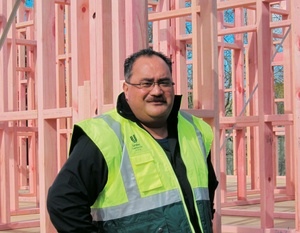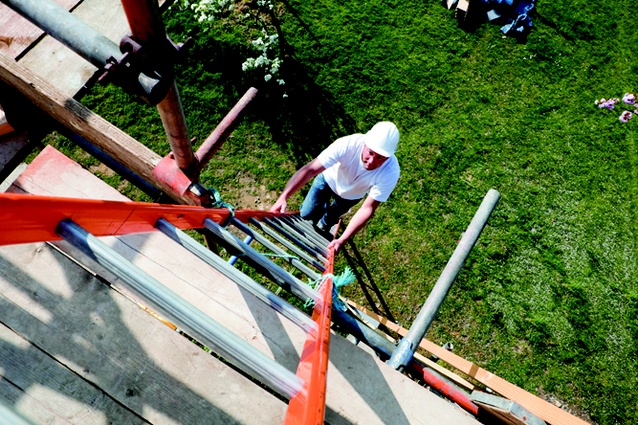Learning Curve
As New Zealand begins one of the biggest rebuilding projects in its history, the demand for skilled and qualified tradespeople will increase substantially.
The latest quarterly New Zealand Construction Sentiment survey makes for interesting reading. According to the report, conducted by Davis Langdon recently, many in the building and construction industry remain concerned about the availability of labour – particularly once more building work begins. Respondents in the survey say there is a shortage of construction and project management services and 39 percent of participants indicated a shortage of skilled trades.
The reasons nominated for this problem revolved around the lure of better prospects overseas – Australia in particular – and the decline in skills as a result of a lack of training in the industry. According to the Department of Building and Housing, 580 more workers in construction-related fields left New Zealand than arrived in the July 2011 quarter. But that is all expected to change very soon.
With $70 billion being invested into the construction industry over the next five years, industry employers are getting ready for a huge increase in demand. An estimated 30,000 newly qualified, skilled construction trades workers will be needed for the Canterbury rebuild and repairing leaky buildings. These factors, combined with the need for building practitioners to become licensed, has seen a significant increase in the need for up-skilling and training throughout the building and construction industries.
Richard Willis, Area Manager at the Building and Construction Industry Training Organisation (BCITO) says his organisation has seen training numbers increase steadily since January this year, indicating that more employers are investing in staff and taking on new carpentry apprentices. This is particularly true in the Canterbury region. “Employers who are up-skilling staff and hiring apprentices want to make sure their employees have all the fundamentals in place before things start to pick up and the work really hits them,” says Willis.
In this year’s budget, the government made available $48 million more for industry training and for trades-related training in polytechnics and this has allowed training providers and polytechnics to add more students to their courses. WelTec is setting up customised carpentry training facilities in Wairarapa and Kapiti – in addition to their existing facilities – to help meet demand. And Unitec’s new Albany campus, which open’s next year, will have extra space for students to practice building houses, over and above the space they currently use at the Mt Albert campus.
WelTec Chief Executive, Dr Linda Sissons says the demand for skilled workers in the construction industry is forecast to skyrocket from the second half of next year. “People need to start training now to be in a good position to pick up this work otherwise New Zealand companies will be looking overseas to fill vacancies,” says Dr Sissons. “People who enrol in training now will be well-placed to meet the expected demand for skilled workers next year and beyond.”
Ruma Karaitiana, Chief Executive of BCITO agrees. “The outcome should be that when demand really picks up we can start injecting people into the industry who have not only pre-employment training but the skills and aptitudes that they can demonstrate to employers.” The BCITO is the largest construction-related industry training organisation in New Zealand and currently has around 5500 students enrolled in construction-related courses including carpentry, concrete, tiling and plastering. Carpentry accounts for over 90 percent of all BCITO apprentices.
From 1 March 2012, building practitioners must be licensed in order to carry out or supervise work on homes and small-medium sized apartment buildings that is critical to the integrity of the building. This ‘restricted building work’ applies to foundations, framing, roofing and cladding. It also applies to active fire safety systems in small-medium sized apartment buildings. Currently the Licensed Building Practitioner Scheme is competency based. Builders and tradespeople with a good track record can have their skills and knowledge formally recognised, whether they are trade-qualified or not. However, with the emphasis turning towards qualification-based licensing, education providers are beginning to offer off job training in conjunction with their other courses.
Daniel Fuemana, head of Building Technology at Unitec, says experienced builders who have not gone through a formal apprenticeship but who need to become qualified and become a licensed practitioner can now take the National Certificate in Carpentry qualification. “This will assist them to meet the requirements of becoming a licensed building practitioner as part of their supporting evidence for their application.”
Fuemana says here have been major changes in the building industry itself with the introduction of new technology, new materials and an increasing emphasis on sustainable building design and their courses have evolved to include these in the curriculum. “Our approach to education is to offer a blended learning environment,” says Fuemana. “This combines theoretical knowledge with the development of hands on skills and incorporates the use of new technology like laptops and smart phones to enhance learning.”
At present, builders do not need to be qualified to be licensed but over time the emphasis on education will increase and from 2015 it is proposed that licensing will be qualifications-based. Off job training allows a trainee or apprentice to complete the theory unit standards for their qualification by attending night classes or block courses at a polytechnic. It can be a good option for people who feel that they need a more structured approach to completing the theory component of their qualification.
“People working on a building site need comprehensive trades skills and a wide range of skills these days,” says Dr Sissons. “There are very few jobs that require a low-skill base. Employers are very focused on the bottom line and doing a good job for a client.” The BCITO says the increase in training numbers is the first positive sign that construction companies are getting ready for a much-anticipated boom in business.
“Employers are getting ready for an increase in consumer demand, as well as preparing for licensing legislation that comes into effect in March next year,” says Willis. He says that training staff now will help ensure companies are in a position to achieve the necessary requirements when licensing laws change. “It’s not just about hiring new apprentices, but also up-skilling existing staff so they will be in a position to supervise less-qualified labour in the future.”
EDUCATION PROVIDERS Q & A
 Dr Linda Sissons WelTec Chief Executive
Dr Linda Sissons WelTec Chief Executive
I notice that another 200 training spots have been added. What was behind that move? Chiefly it was the Christchurch earthquakes and the need to rebuild there. The government recognised some time ago that a large number of people with trades’ skills would be needed in Christchurch. Some estimate that a workforce of around 30,000 will be needed. If people go to Christchurch there will be a shortage in other centres. That, alongside the country’s 42,000 leaky homes in need of remedial work, were the main drivers for the new training.
Was there a need for more people to be trained in the Wellington region and if yes how long had that need existed? As you know the building industry has contracted in recent years with historically low levels of house building throughout the country. When employers pull back they traditionally do not hire apprentices and put training on the back-burner. As work picks up they hire and train again. The problem is the lag time – the time it takes to train people to the right skill level balanced against the requirement to have staff who can work competently on a building site. In Wellington we have experienced less people training in the building and construction, and related industries. The problem, particularly for the latter half of next year, will be not having trades skilled people ready to work when demand is forecast to pick up substantially.
How have the construction-related training options you offer evolved since they started? We have a hands-on approach to learning with our students learning practical skills in our workshops or by building and painting houses at our construction site. Theory classes are taught on our building site. We also offer modular training so that skills are taught in blocks as they are required. We have a strong reputation in the Wellington region for producing graduates with the right skills mix and our focus on quality hasn’t changed, but the way we deliver our training is more targeted to students learning styles and requirements, and what industry wants.
How important is education to this industry and why? The value of education cannot be overestimated. Research shows that people who leave school with no qualifications do not do very well in life – economically and socially. People who study at an institute of technology or polytechnic such as WelTec leave with a qualification, earn more and contribute more. The building industry tells us that leaky homes are a good indicator of what can happen when standards drop.
People working on a building site need comprehensive trades skills and a wide range of skills these days. There are very few jobs that require a low-skill base. Employers are very focused on the bottom line and doing a good job for a client. They cannot do that if the staff they have don’t have appropriate building and construction skills including having appropriate levels of numeracy and literacy.
What would you say are the biggest challenges facing the construction industry today and how might they be overcome? The lack of properly trained and skilled tradespeople is the biggest challenge and it is a serious situation. At WelTec we have industry advisory groups who provide input into our programmes and employ many of our graduates. They tell me that across New Zealand there needs to be a greater emphasis on who and how young tradespeople are trained. Programmes like ours offer more intense training before young people are qualified and go on to be licensed. Our focus is on quality teaching and incorporating industry needs into our training programmes.
What do you think is the single most important skill students learn while studying for the construction related industries? Aside from the skills students learn as part of their trade-specific programme, employers tell me that working independently and having to think for themselves is the single most important skill.
 Daniel Fuemana Head of Building Technology Department Unitec
Daniel Fuemana Head of Building Technology Department Unitec
How long has Unitec been running educational programmes in the building field? Unitec has been involved with the National Certificate in Carpentry (NCC), since its inception, when Unitec was known as Carrington Polytechnic. Unitec continued to present the National NCC programme until 1998. At this time, in consultation and collaboration with Certified Builders Association New Zealand (CBANZ), Unitec decided to deliver an alternative apprentice training scheme which is encompassed in the Certificate in Applied Technology (Carpentry) and the Diploma in Applied Technology Building using the traditional format of the 8000 hours apprenticeship.
How have these programmes evolved since starting? We started quite small offering apprenticeships then evolved into providing pre-trades courses. There has been quite a shift in building training in recent decades. Previously it used to be managed by the Department of Labour (pre 1990s) but now ITOs and NZQA are responsible for this. With these changes, there has been a change from standards-based learning to competency-based assessment. We also offer qualifications now at higher levels such as diploma and bachelor qualifications.
This reflects the change in the building profession where new building codes and regulations have become more demanding and prescriptive about the standard of building work. Our approach to education is to offer a blended learning environment. This combines theoretical knowledge with the development of hands on skills and incorporates the use of new technology like laptops and smart phones to enhance learning.
What do you feel studying building offers students? It provides them with a qualification, and a set of practical skills that can be used in the building industry. Both new students and students who are already working in the industry and up-skilling or updating their qualification gain a lot of confidence from the opportunities we provide to learn new skills. What are the key skills they get from studying? In the building industry, apprentices are taught the process of ‘how’ to build, however, they may not understand the ‘why’ aspect. At Unitec we place a lot of emphasis on teaching students about the building process so that they understand ‘why’ and ‘how’ buildings are put together and the use of different building materials. With guidance from our lecturers this helps to develop their critical thinking and problem-solving skills.
Your website says Unitec’s building technology department is on a first name basis with big players in the industry. Could you describe for us why that is important for you and what it offers students? We have strong links through our staff with professional associations such as the Master Builders Federation, Building Officials Institute of New Zealand (BOINZ), and the New Zealand Certified Builders Association New Zealand (CBANZ). Our staff are engaged in their monthly meetings, including attending and presenting papers at their conferences. We are a partner organisation of the Industry Training Association Building (ITAB) a building industry training organisation. We have an extensive relationship with the building industry ranging from civil, commercial and residential. Unitec has an Apprenticeship Training Trust who employs apprentices and places them with host employers. It’s important for us to engage with the construction industry – it helps us to stay current with modern building practices, materials, codes and trends. It’s also beneficial for our students because it increases their employability as businesses recognise Unitec qualifications and understand who we are and what we offer. Your students build new houses on campus.
Talk us through that process and what the students learn. Do they get a chance to work on all aspects of a house? Our students construct 12 houses over the course of a year here at Mt Albert. We have opened a new campus in Albany and next year students will start to build houses on site. This is a major project for our carpentry students and they learn about all aspects of building construction from being part of the project. Before they start work on the house project, the students spend the first five to six weeks learning health and safety practices, use of hand tools, electrical portable tools, machinery, setting out profiles and are briefed on the build.
Teams are allocated specific parts of the project to work on, and some tasks like erecting the roof trusses may require all team members to help. Their work is supervised by our staff and there is a lot of interaction between the students and lecturers to help solve problems on site. We have suppliers and manufacturers on site to talk to the students about their products and how to use them. We also have QR codes installed on site, which enables the students to scan the code on their smart phones and download instructions or videos.
Will the Licensed Building Practitioner scheme have any impact on the courses you offer and if so, how? The changes being introduced in March 2012 will mean that many more builders will need to be licensed building practitioners. One particular qualification we offer could be very helpful for experienced builders who have not gone through a formal apprenticeship but who need to become qualified and a licensed practitioner. Builders who complete our National Certificate in Carpentry qualification will find this will assist them to meet the requirements of becoming a licensed building practitioner as part of their supporting evidence for their application. There is a also a need for builders to keep up-to-date on new technology or regulations and we offer a range of short courses covering various topics which can be combined with full time work.
What are the biggest challenges providing education to this industry at this time and how can they be overcome? At the moment one of the challenges has been the fact that we are coming out of a recession and that the building industry has been affected by this. Looking ahead there is clearly going to be a strong demand for qualified tradespeople and we see it as being really important that the construction industry keep up-skilling their workforce and taking on apprentices where they can to prepare for an increase in work.
Part two: The lecturer and the students










